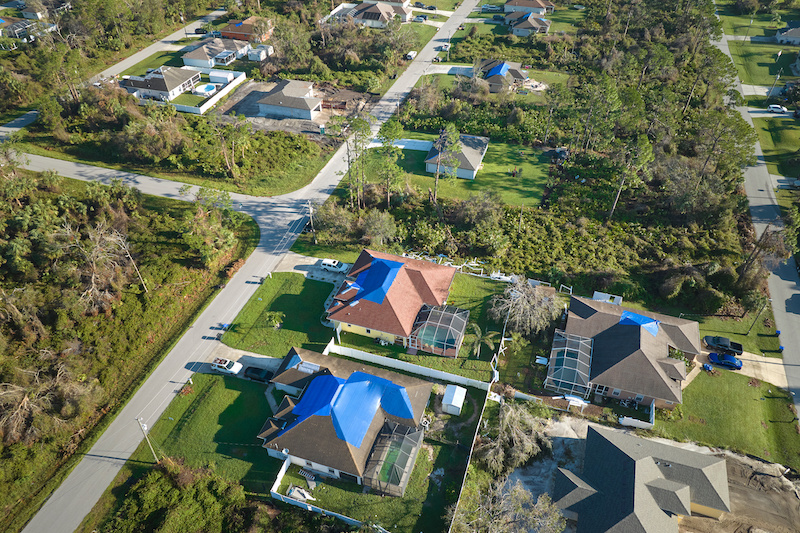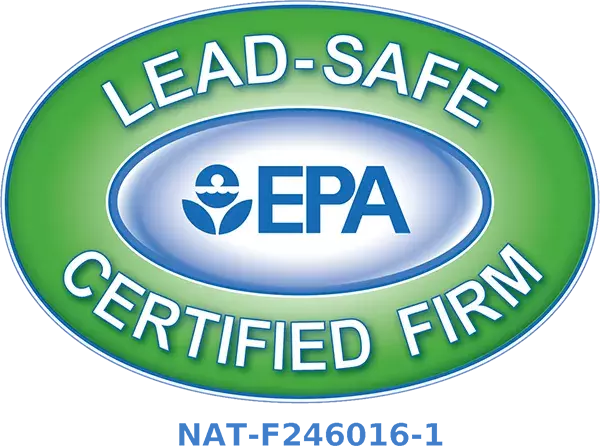Imagine you’re cozied up with a hot cup of cocoa, watching the snowfall. Suddenly, you notice a dark spot spreading across your ceiling – an unwelcome guest from the winter storm outside: roof leakage. You need an emergency roof tarp, and fast.
You’re not alone in this predicament; it’s happened to many homeowners like yourself. Is there a way to stay ahead of these unexpected occurrences? What if you could protect your home swiftly before damage worsens?
This post will help guide you through understanding emergency tarps, recognizing situations that require them, and navigating insurance claims for such incidents. It’ll also offer tips on selecting professional tarping services and maintaining your roofs after installation.
The clock is ticking as each droplet finds its way into your sanctuary… Are you ready to fight back?
Table Of Contents:
- Understanding Emergency Roof Tarping
- Situations Necessitating Emergency Roof Tarping
- The Process of Installing an Emergency Roof Tarp
- The Importance of Insurance in Emergency Roof Tarping
- Choosing the Right Emergency Roof Tarping Service
- Precautions Before and After Emergency Roof Tarping
- FAQs in Relation to Emergency Roof Tarp
- Conclusion
Understanding Emergency Roof Tarping
Having sustained roof damage can be a very serious issue, as it may cause water leaks and mold infestation if left unchecked. Damage to your roof can lead to leaks, mold growth, and more problems down the line. That’s where emergency roof tarping comes into play.
A roof tarp, also known as an emergency roof tarp, is not just any ordinary sheet of plastic. It’s a temporary shield that provides protection against weather conditions like rain or wind until professional repairs can be made.
The Purpose and Functionality of Emergency Roof Tarps
Emergency tarps serve one main purpose: protecting your home from further damage after an incident has compromised its structural integrity. Whether it’s due to severe weather or unexpected accidents such as fallen trees; these sturdy sheets provide instant cover for exposed areas on your rooftop.
This means less chance for water spots or worse – water seeping into your house causing additional harm. Now imagine if this were during hurricane season in South Florida… I shudder at the thought.
Remember though – while effective temporarily, tarps are by no means a long-term solution for extensive damage repair. According to research, “Emergency roof tarping provides temporary protection to homes from various types of damage.”
Proper installation is crucial for getting the most out of emergency roofing solutions, as emphasized by Beyond Exteriors. They stress the importance of correctly installing these temporary fixes to ensure maximum benefits and avoid further problems.
You don’t want some loose-fitting tent flapping in high winds. It needs to be secured properly with deck screws and silicone coatings to ensure it doesn’t become a hazard itself.
Professional roof tarping services like J&R Restoration in South Florida have the right expertise, tools, and experience for this kind of job. They can install your emergency roof tarp correctly – protecting you from more headaches.
Emergency roof tarps are not your average plastic sheets. They’re temporary shields against harsh weather, giving you time to arrange professional repairs. But remember, they need proper installation – no loose ends flapping in the wind. It’s best to hire professionals like J&R Restoration who have the right skills and tools for the job.
Situations Necessitating Emergency Roof Tarping
Roof damage can occur in the blink of an eye. One minute you’re enjoying the comforts of your home, and then suddenly – boom. A fallen tree or severe storm shakes up everything. But don’t worry, that’s where emergency roof tarps come into play.
Impact of Severe Weather on Roofs
The wrath Mother Nature unleashes can be unpredictable and brutal. Bad weather is often the main culprit behind significant roof damage. From hail storms to high-speed winds, each event brings its unique challenges.
Hurricanes, for instance, are infamous for tearing off shingles or even entire sections of roofs. This kind of damage leaves homes exposed to rainwater infiltration leading to water damage.
Poor weather conditions like these lead many homeowners to scramble for immediate solutions – enter emergency tarp service.

Accidental Damage and Vandalism
Moving beyond natural disasters, let’s talk about human-caused damages such as accidents or vandalism which may also necessitate urgent action.
A rogue baseball from a neighborhood game could break through roofing material causing leaks when it rains next time around, while intentional acts like arson would require much more than just minor repairs but temporary coverings until proper restoration takes place.
No matter what type of situation you find yourself dealing with – extreme climate events or accidental property harm due to random chance happenings – we’ve got your back here at J&R Restoration. We provide quick and effective measures to protect against further loss or damage using our expertise in installing quality durable tarps onto affected areas, helping preserve the integrity of the structure while reducing potential mold growth inside caused by water intrusion. Don’t delay – contact us now and let us assist you in getting through the rough times.
Roof damage can strike at any moment, from sudden storms to unexpected accidents. Emergency roof tarps are a lifeline, offering quick protection against further loss and water intrusion that could lead to mold growth. Whether you’re facing extreme weather or accidental harm, J&R Restoration is here with durable tarp solutions tailored for your needs.
The Process of Installing an Emergency Roof Tarp
When your roof is damaged, a tarp can be a quick fix to prevent further harm. Throwing up a bit of plastic and expecting it to work isn’t the most effective way of installing an emergency roof tarp.
The Role of Professionals in Tarp Installation
A professional roof tarping service knows how to temporarily cover the damaged area correctly. Proper implementation of the roof tarping process not only secures your home from leaks but also prepares it for future repairs.
Relying on professionals ensures that your temporary solution won’t cause more problems down the line due to improper installation. Plus, they have all the necessary equipment like inch deck screws and silicone coatings at their disposal.
Preliminary Steps Before Installation
To start with, professionals assess the roof’s condition thoroughly. They look out for issues such as ice dams or water spots that indicate potential leak points.
If there are broken windows or other damages apart from just roof damage, emergency board-up services might be needed too. In such cases, business owners often prefer calling one company that provides both these services instead of coordinating between two different ones.
Tackling The Task: Step-by-Step Guide
Firstly, using long-term tarping material (usually blue polyethylene), experts measure enough material to extend past the roof peak on either side of any visible damage. Then this is secured using 1-inch deck screws along its edges into roofing joists wherever possible.
This process needs precision and should ideally avoid causing additional punctures in undamaged parts, hence needing skilled hands. The next step involves making sure no loose areas remain where wind could get under it since strong weather conditions can rip off even properly installed tarps if left unchecked. For this, they often use additional straps or ropes over the tarp.
Post-Installation Care
Once installed correctly, a roof tarp can be an effective temporary solution for weather protection until full repairs are done. It’s crucial to keep in mind that tarps aren’t a permanent fix and should be replaced with proper roof repairs as soon as possible. That’s why our emergency repair services go beyond just quick fixes—we also provide comprehensive solutions designed to address the root of your roofing issues.
Don’t skimp on quality when it comes to emergency roof fixes. Let professionals do their job so that your home stays safe from weather-related harm.
The Importance of Insurance in Emergency Roof Tarping
Dealing with a damaged roof can be stressful. Navigating the insurance realm when addressing roof damage can be a complicated and intricate endeavor. However, understanding your policy and how to make a claim for emergency roof tarp services is vital.
Filing an Insurance Claim for Roof Damage
Navigating property insurance claims after an unexpected incident isn’t always straightforward. You may ask yourself: “What damage will my policy cover? How do I protect my home from further harm while waiting on approval?” These questions are common and quite important.
To start off, you need to inform your insurer about the damage as soon as possible – this might require a service call depending on their process. Typically, they’ll want details about what happened and photos showing the extent of the destruction. Filing an insurance claim involves these steps among others:
- Gather evidence (pictures or videos).
- Contact your insurance company promptly.
- Provide accurate information regarding the circumstances leading up to the damage.
Your insurer will then assess if emergency roof tarping falls under covered damages within your plan. Research indicates that most property insurance companies recognize such temporary protective measures, so they often reimburse homeowners who have had professional tarp installations following severe weather conditions or accidents causing substantial leaks or breaks in their roof structure (The Balance).
In cases where coverage applies, insurers typically compensate based on estimates provided by certified roofing professionals. So, getting a trustworthy contractor involved early in the process can make things go more smoothly.
Finally, remember to keep copies of all communications and receipts related to your claim. These documents will be crucial if any questions arise later about your insurance company’s obligations or the steps you took to mitigate damage.
To sum up: Filing an insurance claim for emergency roof tarping isn’t necessarily complicated but does require some savvy navigation. By understanding how it works, homeowners can protect their properties without undue financial stress.
Understanding your insurance policy and the process of making a claim for emergency roof tarp services is crucial when dealing with roof damage. Notify your insurer promptly, provide detailed information about the incident, and involve a reliable contractor early on. Keep all relevant documents handy to avoid financial stress while protecting your home.
Choosing the Right Emergency Roof Tarping Service
When nature strikes, that’s where emergency roof tarp services come into play. But how do you choose the right one?
Evaluating Potential Roof Tarping Services
The first step in choosing a service provider for emergency roof tarping is to evaluate potential companies based on their expertise and reliability.
A good starting point is to ask if they offer both board-up and restoration services. This can be critical as some situations might require more than just tarping. For instance, if there are broken windows or other structural damage due to severe weather conditions or vandalism.
You also want to ensure that any company under consideration employs certified roofing contractors who understand how best to protect your property while repairs are being arranged.
Another important aspect of evaluation involves checking reviews from previous customers. Look for consistent positive feedback regarding timely response, professional conduct during the service call, and quality workmanship with regard to their roofing repair process.
Commercial Storm Damage Repair & Restoration
This isn’t just about getting immediate help but making sure that this temporary solution doesn’t lead to bigger problems like water spots inside your house because of roof leaks not addressed properly at the initial stages.
If these criteria aren’t met by a prospective contractor, then it’s better to keep looking until you find someone up to the mark.
In addition, insurance considerations should also play a part in the selection procedure since many homeowners will need to file a claim following significant damage. Hence, cooperating well with the claims process becomes an essential trait too.
“Don’t let an urgent situation force you into making a hasty decision. Take your time, evaluate all options, and choose wisely.”
Find a squad that is agile, proficient, and devoted to accomplishing the task properly. Take your time to ensure you find the right service that will protect your home from further damage. Take the necessary steps to ensure you have a team that meets your expectations of speed, efficiency, and quality.
When picking an emergency roof tarp service, don’t rush despite the urgency. Look for a reliable team offering both board-up and restoration services with positive customer feedback on timeliness, professionalism, and quality workmanship. Make sure they can address potential leaks to prevent future issues like water spots inside your home. Lastly, find someone who understands insurance claims processes well – this will help ensure smooth sailing during a stressful time.
Precautions Before and After Emergency Roof Tarping
Taking precautions before and after emergency roof tarping can save you from a lot of headaches down the road. When done right, it acts as a temporary solution to protect your property until full repairs are completed.
Maintaining Your Roof Post-Tarp Installation
To start off with, regular roof inspections are vital post-tarp installation. These inspections help spot potential issues like water spots that indicate leaks or damage not covered by the tarp. This way, you prevent further damage while waiting for comprehensive repair work.
The presence of moisture under the installed tarp is another common issue homeowners face after installing an emergency roof tarp. Conducting a routine moisture inspection becomes crucial in such cases to ensure no mold growth or rot sets in underneath.
An improperly secured roof tarp can cause more harm than good if left unchecked. Hence checking whether it’s installed correctly should be part of your maintenance regimen too. And remember, this isn’t just about looking at the surface; examining aspects like deck screws being securely fastened matters equally.
Beyond these steps though, understanding when professional help is needed forms a critical part of maintaining your home post-tarping effectively too. Sometimes there might be signs that demand attention beyond what layman’s eyes can catch – warped wood or shingles hinting at structural damage could be some examples.
At times like these turning towards professionals who specialize in assessing damaged roofs proves invaluable. They’ll give thorough feedback on how bad things stand and advise accordingly – maybe even suggesting long-term solutions instead of relying solely on tarps for protection against harsh weather conditions.
To sum up, the key to ensuring your property stays safe before and after emergency roof tarping lies in regular inspections, proper maintenance practices, and calling in professionals when needed. Ensuring your residence is safeguarded from further harm until a definitive solution is put in place can be accomplished by taking the necessary steps.
Smart steps are needed both before and after installing an emergency roof tarp to keep your home safe. This includes regular inspections, proactive maintenance like checking for moisture or loose fastenings, and getting professional help when you spot serious damage. With these practices in place, you can relax knowing your property is protected from more harm until the full repairs are carried out.
FAQs in Relation to Emergency Roof Tarp
How do you tarp an emergency roof?
You can secure a damaged roof with a sturdy, waterproof tarp. Stretch it over the damage and fasten it down using nails or bungee cords.
How do you temporarily patch a roof with a tarp?
To temporarily patch your roof, position the tarp to cover the leaky area completely. Secure its corners using roofing nails or heavy-duty staples for optimal protection.
Will a tarp stop a roof leak?
A properly installed emergency roof tarp will provide temporary relief from leaks by diverting water away from vulnerable areas of your rooftop.
How long can I leave a tarp on my roof?
An emergency tarp is only temporary; ideally no more than 90 days. Beyond this point, professional repairs are necessary to avoid further damage and ensure safety.
Conclusion
Emergency roof tarping is a must-know for every homeowner. You’ve learned that it serves as an immediate fix to protect your home from further damage, be it due to harsh weather or unfortunate incidents.
Don’t delay; be prepared for any eventuality. Understand when and why emergency tarps are needed, and how professionals install them correctly for maximum protection.
Navigate insurance claims with ease now that you know they often cover such situations. Remember: hiring professional tarping services is key to quality workmanship.
An ounce of prevention is worth a pound of cure; stay prepared with this essential guide on emergency roof tarps.
Moving past roof tarping services, at J&R Restoration we also excel at mold remediation, fire damage restoration, interior remodeling, and more.


